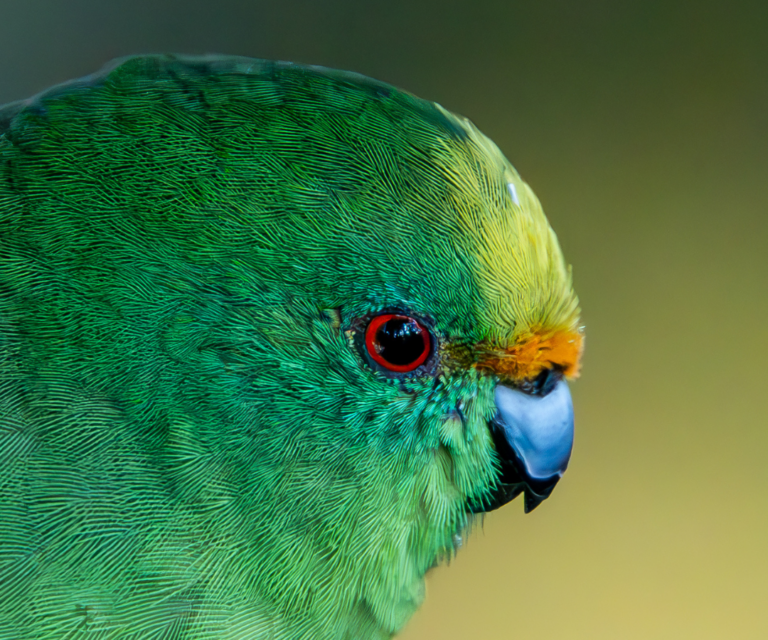Voting has now closed for Bird of the Year 2025. The winner is…. Kārearea | New Zealand falcon!
Even though the Kākāriki Karaka didn’t win, we’re still incredibly proud to champion them and to have the world’s largest population of this Threatened–Nationally Critical bird in the Sanctuary.
Come visit and see if you can spot the flash of green amongst the trees or hear their distinctive call.
Once widespread across Aotearoa, the kākāriki karaka is now our rarest parakeet – twice thought extinct and clinging to survival in just a handful of places. Here at the Brook Waimārama Sanctuary, they’ve made an incredible comeback. Since their reintroduction in 2021, our thriving population is now the largest in the country.
As the South Island’s largest fenced sanctuary, we provide these bright‑eyed manu with a predator‑free haven, abundant food, and space to breed. Every visit, donation and membership helps protect this taonga species – and strengthens the fight to keep them here for generations to come.

FAQ
Since the first translocation in November 2021, the Sanctuary population has grown rapidly. Following multiple releases in 2021, 2022, and 2023, surveys now estimate at least 300 birds with a minimum of 250 birds, making this the largest known population in the country (and globally).
Kākāriki karaka (orange‑fronted parakeet) are Aotearoa’s rarest parakeet and one of our most endangered birds. Once found across the motu, they now survive in only a handful of locations. Twice declared extinct, their return to the Nelson region after a 100‑year absence is a major conservation success — and proof that the pest‑free Sanctuary is working.
The transfers were a collaboration between Department of Conservation (DOC), Te Rūnanga o Ngāi Tahu, captive‑breeding facilities such as The Isaac Conservation and Wildlife Trust and Orana Wildlife Park, and the Brook Waimārama Sanctuary team. Air New Zealand supported the transfers, flying birds from Christchurch to Nelson. Volunteers, iwi representatives, ecologists, and support partners all played key roles.
A translocation is the careful capture, transport, and release of a species into suitable habitat to establish or boost a population: In our case, the aim is to reintroduce kākāriki karaka.
All captive-bred kākāriki karaka translocated to the Brook Waimārama Sanctuary were acclimatised for two nights in special on‑site aviaries before being released into the wild.
Success means the establishment of a self‑sustaining population with enough numbers and genetic diversity to thrive without further releases. This can take years and may involve multiple follow‑up translocations. The rapid growth of the Sanctuary’s kākāriki population is a strong sign we’re on track.
They are a taonga species for Ngāi Tahu, with deep cultural significance and centuries‑old connections in te ao Māori. Their bright green plumage, orange forehead, and cheeky personality make them instantly recognisable — but their survival is far from assured. The Sanctuary offers them a safe, pest‑free home with abundant food and nesting sites.
The 14‑km pest fence and ongoing biosecurity vigilance keep introduced mammals out. Intensive pest monitoring, habitat protection, and public reporting of sightings all help. The Sanctuary’s high connectivity to the 166,000 ha Mount Richmond Forest Park means that some birds will disperse beyond the fence into unprotected habitat, but abundant resources inside will encourage a core population to stay.
Bird of the Year is run by Forest & Bird every year to raise awareness for our native wildlife, their habitats, and the threats they face. Find out more here – https://www.birdoftheyear.org.nz/
Kākāriki karaka prefer native beech forests, where they feed on invertebrates, fruits and seeds. At the Sanctuary — the only fenced sanctuary in Aotearoa made up primarily of beech forest — they’re perfectly at home.
Originally, they would have occupied the middle canopy layer, while red-crowned kākāriki are more often found lower down, and yellow-crowned kākāriki higher up. Kākāriki karaka are also the smallest of the three.
In years when the beech forest masts (producing large quantities of seed), kākāriki karaka are likely to benefit from a longer and more successful breeding season. With the next mast expected soon, we’re hopeful it will support another boost to our growing population.

Photographer: Sean McGrath
























